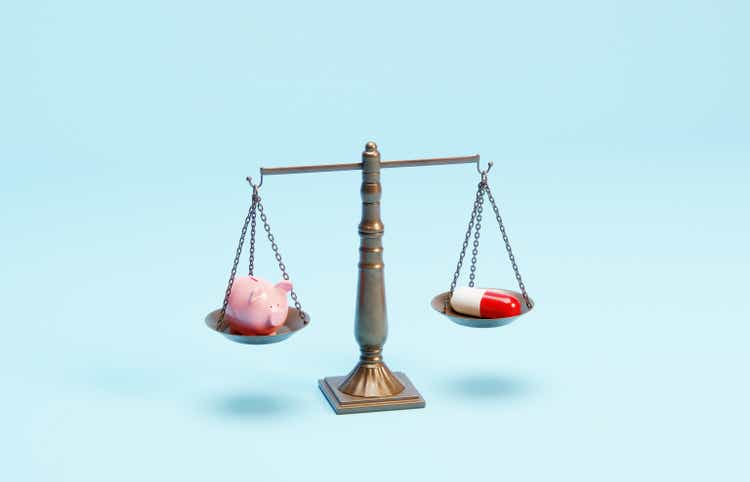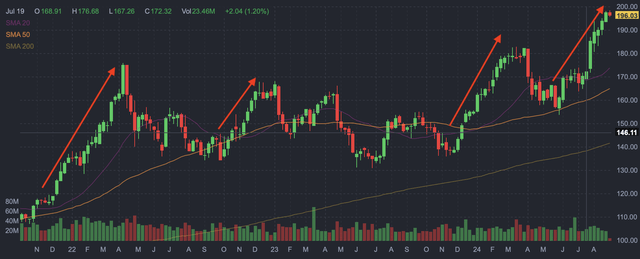Summary:
- AbbVie shares are nearing $200, likely facing resistance and a potential pullback to test support between $175 and $185.
- Despite strong dividends and share buybacks, AbbVie’s higher P/E ratio and heavy reliance on Humira and other drugs that could face pricing pressure present risks.
- Recent acquisitions and political scrutiny, including Medicare price cuts, add uncertainty to AbbVie’s near-term outlook.
- I recommend holding off on adding shares until after a potential pullback and the upcoming election period.

J Studios
AbbVie (NYSE:ABBV) appears to be breaking out yet again. The company was considerably undervalued for several years, but has performed exceedingly well for the last three. Now, shares are approaching $200, and it appears reasonable likely that they are due for a rest here, and a possible test of support. It is not entirely clear where strong downside support may be, but it is likely to be at or between $175 and $185. For this reason, I am willing to wait for a test of this level and would only consider adding shares upon seeing ABBV bounce off that level and make a second approach at the $200s.
AbbVie is a Dividend Aristocrat that is likely to increase its quarterly payout every year, and it generally does so in the fall. AbbVie is also a regular repurchaser of shares. Further, AbbVie’s fairly consistent domestic cash flow is an extremely desirable factor in most markets. Nonetheless, we appear to be in a weakening dollar environment, where the market may now prefer companies with higher levels of international revenue.
In July, AbbVie reported its Q2 2024 results, which were positive and well received. AbbVie’s Q2 EPS came in at $0.77, and adjusted diluted EPS was $2.65. These numbers were lower than in the prior year, but this was at least partially due to a certain non-recurring acquisition related expenses that impacted results by $0.52. Revenue was $14.462 billion, which was a 4.3 percent increase on a reported basis, and up 5.6 percent on an operational basis.
AbbVie also raised its 2024 guidance slightly, from an adjusted diluted EPS range of $10.61-$10.81 to $10.71-$10.91. These numbers are decent, but actually well below the high $13 to low $14 per share it was making annually just a couple of years back. Given current EPS expectations and ABBV’s share price, it is trading at a price to earnings valuation of around 19x, which is fairly high for it.
AbbVie’s heavy reliance upon Humira remains a frequently discussed risk. In particular, the market has anticipated biosimilar competition as an inevitability for quite a while. Despite this, AbbVie has proven remarkably capable at extending the drug’s market and revenue strength. Nonetheless, Humira revenues have been declining.
Last quarter, AbbVie’s global Humira net revenues were $2.814 billion, a decrease of 29.8 percent on a reported basis, or 28.9 percent on an operational basis. Domestic Humira net revenue was $2.360 billion, a decrease of 31.6 percent, and international Humira net revenue was $454 million, a decrease of 18.9 percent on a reported basis, or 12.5 percent on an operational basis. This significant decrease in Humira revenue appears to be both due to some competition, as well as lower domestic pricing.
In addition to Humira, AbbVie’s other immunology drugs are also blockbusters. Skyrizi’s global net revenue was $2.727 billion, an increase of 44.8 percent on a reported basis, or 45.6 percent on an operational basis. Also, Rinvoq’s quarterly net revenue was $1.430 billion, an increase of 55.8 percent on a reported basis, or 59.2 percent on an operational basis.
AbbVie continues to benefit from its 2019 acquisition of Allergan, which was then under-appreciated by the market. Allergan provided AbbVie with much-needed diversification from Humira, and Allergan brought multiple new profitable drugs and divisions into the portfolio.
Allergan was probably best-known for its aesthetic and/or cosmetic treatments, including Botox, Juvederm, and CoolSculpting, all of which continue to perform well. Last quarter, global net revenues from AbbVie’s aesthetics portfolio were $1.390 billion, with Botox bringing in about $729 million in aesthetic revenue, plus $814 million from Botox Therapeutic. Juvederm provided revenue of $343 million.
Allergan also had a neuroscience division that included Vraylar, which is a fast-growing atypical antipsychotic blockbuster. Global net revenues from the AbbVie’s neuroscience portfolio were $2.162 billion, an increase of 14.7 percent on a reported basis, or 15.2 percent on an operational basis. In addition to the above-mentioned revenue from Botox Therapeutic, Vraylar’s net revenues were $774 million, an increase of 17.6 percent. Also, AbbVie’s total revenue from Ubrelvy was $231 million, an increase of 17.5 percent, and Qulipta’s quarterly net revenues were $150 million, an increase of 56.3 percent.
AbbVie is in the midst of an extended move up the charts that has taken shares to new highs. As it now approaches $200, there is reason to believe that the company’s share price may soon need to take a breather and test support. Reasons for this include that the company has a history of making similar moves up the chart, followed by periods of contraction.

ABBV weekly candlestick chart (Finviz.com with red arrows by Zvi Bar)
Over the last three months, ABBV shares have appreciated by over 26 percent, or about 41 dollars per share. This is a significant move for such a large company. Therefore, it appears reasonably likely that AbbVie may soon go through another contraction period, or that this current move upward will not be able to continue indefinitely. Here, it appears reasonably likely that ABBV shares must soon either remain range bound or potentially decline and test levels of downside support. There is also some likelihood that $200 will present a psychological level of resistance to a continued move higher.
Other possible reasons that AbbVie may find some resistance to further near-term upside is the possibility it soon makes yet another acquisition. AbbVie has been a habitual acquirer of smaller biotech entities, and recently completed the $8.7 billion acquisition of Cerevel Therapeutics for its pipeline of neurological assets. AbbVie’s next acquisition could soon come, and biotech asset values are reasonably elevated, while not necessarily providing value.
For example, while Cerevel may include a one-day meaningful drug, its pipeline could also end up being worth less than what AbbVie paid. Cerevel’s pipeline includes some late-stage assets, such as Tavapadon for Parkinson’s, which is in phase 3, and Emraclindine for Schizophrenia, in phase 2, and Alzheimer’s disease, in phase 1. Cerevel’s pipeline also included Darigabat for epilepsy and an early-stage dementia drug (CVL-871). The poor performance of these drugs in their clinical trials could instigate a downtrend in ABBV shares.
Another common and continuing risk that AbbVie faces is that it is a target for political scrutiny. In the past, the House Oversight Committee scrutinized the company’s use of patents in order to extend Humira’s protection from competition. Also, the Senate Finance Committee has investigated AbbVie’s use of international corporate domiciles and tax law. It would not be shocking for it to yet again become the focus of such oversight.
The U.S. government also recently announced final pricing for the first 10 Medicare Part D drugs negotiated under the Biden administration’s Inflation Reduction Act. That list included Imbruvica, a blood cancer drug marketed by AbbVie that is its highest revenue oncology medication. Last quarter, Imbruvica’s net revenues were $833 million, and U.S. net revenue was $595 million. This newly negotiated pricing results in a 38% reduction in the price paid by Medicare for Imbruvica. Other medications could eventually sustain similar cuts.
Further, it is often the case that large pharmaceutical companies underperform in the weeks and months in advance of a domestic election. While such risk and downturns are usually short-lived, they occur and often result in much lower temporary valuations. Since this occurrence is reasonably likely in the next few months, it presents as yet another reason to expect ABBV shares to soon cool off their recent run up the chart.
Conclusion
ABBV provides a well-covered dividend that is likely to be increased in the fall, but shares are trading at a high valuation due to a strong performance over the last several weeks. As we approach the presidential election and ABBV shares approach the possible psychological barrier of the nice and round $200 per share mark, there exists a reasonable probability that shares will soon find temporary resistance to continued appreciation. I believe shares are likely to cook off in September and October, and test support in advance of the election. For this reason, I am refraining from adding shares here, and I am unlikely to do so in the next few months.
Analyst’s Disclosure: I/we have a beneficial long position in the shares of ABBV either through stock ownership, options, or other derivatives. I wrote this article myself, and it expresses my own opinions. I am not receiving compensation for it (other than from Seeking Alpha). I have no business relationship with any company whose stock is mentioned in this article.
Seeking Alpha’s Disclosure: Past performance is no guarantee of future results. No recommendation or advice is being given as to whether any investment is suitable for a particular investor. Any views or opinions expressed above may not reflect those of Seeking Alpha as a whole. Seeking Alpha is not a licensed securities dealer, broker or US investment adviser or investment bank. Our analysts are third party authors that include both professional investors and individual investors who may not be licensed or certified by any institute or regulatory body.
